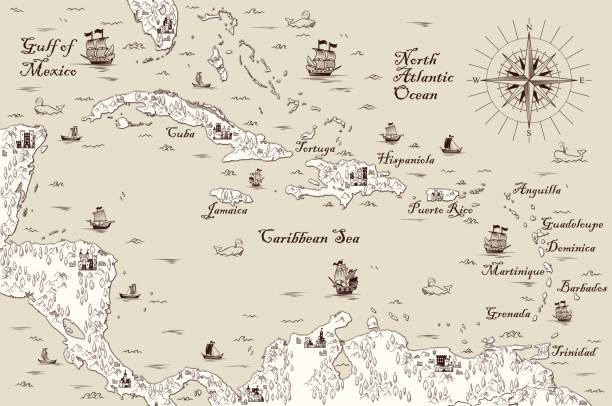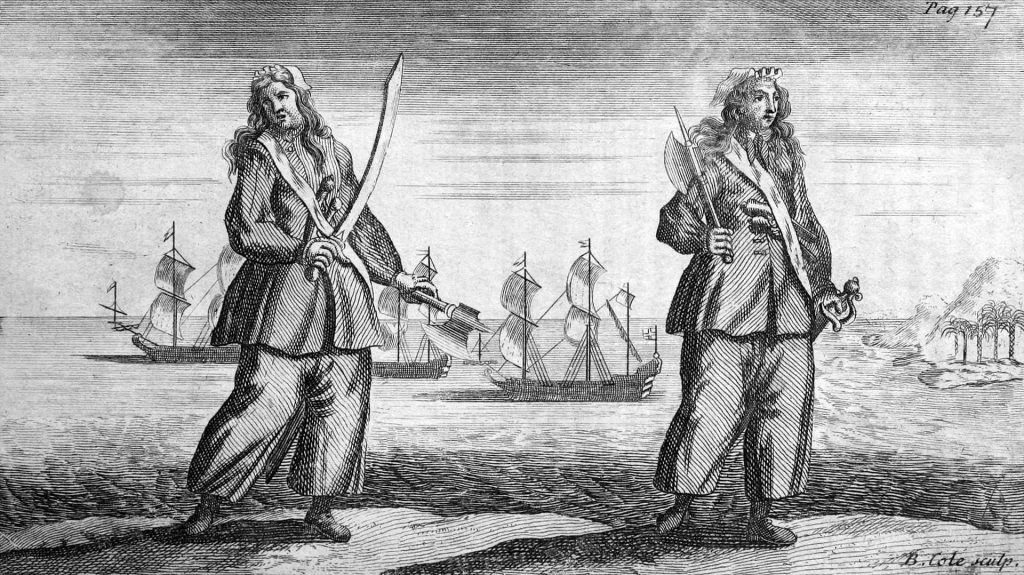Piracy in the Caribbean was far more than swashbuckling tales of lawlessness at sea. It was a shifting phenomenon shaped by European rivalries, colonial expansion, and the opportunities of maritime trade. From their early days as hunters turned buccaneers to their eventual suppression in the 18th century, pirates left an indelible mark on the region’s history. Romanticised in popular culture but rooted in harsh realities, their story reveals how piracy influenced trade, settlement, and society across the Caribbean.
The timeline below highlights some important aspects of this turbulent era and its lasting legacy.
1. The Geography of Piracy
The Caribbean’s geography made it a natural base for piracy. Its narrow straits and island chains offered sheltered anchorages and escape routes, while shipping lanes carried treasure, sugar, and supplies between Europe and the Americas.
Ports such as Tortuga, Port Royal, and later Nassau provided havens where pirates could resupply, repair ships, and trade plunder. The region’s central location meant that pirates could strike at merchant convoys from multiple European nations, reinforcing the Caribbean’s reputation as a maritime crossroads of both commerce and crime.
 Old map of the Caribbean Sea, Vector illustration via iStock
Old map of the Caribbean Sea, Vector illustration via iStock2. Rise of the Buccaneers (1630s–1650s)
The first wave of pirates in the Caribbean were the buccaneers, who emerged in the 1630s. Many were displaced French hunters and seamen who settled on Hispaniola and Tortuga after being excluded from Spanish colonial holdings. Their name derived from the “boucan,” a wooden frame used to smoke meat, which they sold to passing ships.
Over time, these hunters took to the sea, attacking Spanish shipping and coastal towns. The buccaneers thrived on the edges of empire, filling the vacuum created by weak colonial defences and fuelling a cycle of raiding that unsettled Spain’s hold over the region.
3. Privateers and the English Crown (1655–1670s)
After England seized Jamaica from Spain in 1655, privateers became central to imperial strategy in the Caribbean. Maintaining a permanent navy was prohibitively expensive, so the Crown issued letters of marque—official commissions that authorised private captains to raid enemy ships and settlements. In wartime, these were called letters of marque, while in peacetime, similar commissions known as letters of reprisal allowed subjects to seek redress against foreign rivals in the absence of formal insurance or legal remedies.
This system effectively transformed plunder into a business: captains and crews were rewarded with a share of captured goods, while the Crown and colonial officials took the rest. Profits were so great that wealthy merchants and nobles financed expeditions in return for a cut, turning privateering into a commercial enterprise that poured immense wealth into Port Royal and boosted Jamaica’s economy.
In practice, privateers served as England’s frontline defence in the Caribbean, harassing Spanish shipping and striking settlements to weaken Spain’s grip on the region. Yet the line between sanctioned warfare and outright piracy was thin. Commissions often lapsed or were exceeded, alliances between European powers shifted constantly, and colonial governors frequently looked the other way when privateers attacked ships not covered under their licence. This ambiguity, combined with the chaotic nature of international relations in the 17th century, meant that Port Royal thrived as both a hub of legitimate privateering and a haven for men whose exploits edged into piracy.
4. Henry Morgan & the Peak of Buccaneering (1660s–1670s)
Henry Morgan epitomised the height of buccaneering. Operating out of Port Royal, Morgan led audacious assaults on Spanish strongholds, including Portobelo in 1668 and Panama City in 1671. His campaigns brought immense spoils to Jamaica and enhanced England’s position in the Caribbean. Though often denounced as a pirate by Spain, Morgan was rewarded with a knighthood in 1674 and later served as lieutenant governor of Jamaica.
Yet Morgan’s story took an ironic turn. Once celebrated as the scourge of the Spanish Main, he returned to Jamaica as a royal official and distanced himself from the very men who had made Port Royal infamous. As lieutenant governor, he oversaw the trial and execution of many former pirate colleagues, signalling a shift in official policy from tolerating buccaneers as assets of empire to punishing them as liabilities. His career illustrates how piracy and imperial strategy were intertwined, with colonial authorities both condemning and rewarding acts of maritime plunder depending on political expediency.
5. Pirates and the Slave Trade
Piracy intersected with the transatlantic slave trade in complex ways. Some pirates attacked slave ships to seize valuable human cargo, while others freed enslaved Africans who then joined their crews. Pirates were also active along the African coast, disrupting slave-trading forts and raiding vessels bound for the Caribbean.
Enslaved and formerly enslaved people sometimes found in piracy a brutal yet alternative path to freedom. These entanglements highlight how piracy was enmeshed in the wider systems of forced labour and commerce that underpinned the colonial Caribbean.
6. Women Pirates in the Caribbean (Late 1600s–1700s)
Though rare, women played notable roles in Caribbean piracy. Figures such as Anne Bonny, of Irish descent but raised in the Bahamas, and Mary Read, who disguised herself as a man to serve at sea, became notorious in the early 18th century. Both sailed with Calico Jack Rackham and were captured in Jamaica in 1720. Their stories challenged contemporary norms about gender and seafaring, and they remain some of the most enduring figures from the age of piracy.
 Engraving of Anne Bonny and Mary Read holding swords, circa 1730
Engraving of Anne Bonny and Mary Read holding swords, circa 17307. Jewish Pirates and Merchants
Another less-told dimension of Caribbean piracy involved Jewish pirates and merchants. Many were Sephardic Jews who had fled Iberian persecution and settled in tolerant Dutch and English colonies such as Curaçao and Jamaica. Some engaged directly in privateering against Spanish shipping, seeking revenge against the empire that had expelled them. Others supported piracy indirectly by financing voyages, trading plundered goods, or providing intelligence networks. Their involvement illustrates the diverse groups who exploited the opportunities piracy presented.
8. Pirates – Foes of the Crown (Late 1600s–early 1700s)
By the late 17th century, shifting alliances and peace treaties reduced the usefulness of privateers to European powers. Many seafarers who had once operated legally turned to outright piracy, attacking ships from all nations, including their former patrons. This breakdown of official sanction blurred the lines further, as former privateers became enemies of the state. The decline of piracy in the Caribbean mirrored wider changes in Europe. Following the end of the Thirty Years’ War, national power expanded, and armies were codified under royal control. Private mercenaries and privateers alike lost their legitimacy as governments centralised authority. Naval fleets grew stronger and were tasked directly with combating piracy, first in European waters and then across the Atlantic.
As the Crown tightened its grip, Port Royal—once a haven for privateers and buccaneers—was transformed into a place of reckoning. Gallows were erected on the waterfront, and captured pirates were hanged publicly, their bodies often left on display as a warning to others. What had been a bustling hub of plunder and profit became infamous as the “pirates’ graveyard.” The “Golden Age” buccaneers of the late 1600s thus gave way to the infamous outlaws of the early 18th century—figures such as Blackbeard, “Calico Jack” Rackham, and Charles Vane. Unlike earlier privateers who operated with Crown approval, these men were operating entirely outside the law. Their notoriety brought them fame, but also sealed their fate: capture, trial, and execution were the inevitable outcomes of careers no longer sheltered by royal commissions.
9. The 1692 Earthquake and the Fall of Port Royal
Port Royal, once dubbed the “wickedest city on earth” for its wealth and vice, was devastated by a massive earthquake in June 1692. Much of the town sank into the sea, killing thousands and destroying what had been the Caribbean’s premier pirate haven. The disaster marked a turning point: the English Crown shifted its focus to Kingston as a new commercial centre, and Port Royal never regained its former prominence. The earthquake symbolised the fragility of pirate strongholds and their dependence on shifting political and environmental conditions.
10. Piracy’s Decline and Legacy (1700s–1720s)
By the early 18th century, piracy’s golden age was coming to an end. European powers, once reliant on privateers to disrupt rivals, shifted to suppressing piracy in favour of stable trade and colonial expansion. In Jamaica, Port Royal became the centre of these crackdowns. Gallows Point earned grim notoriety as an execution ground, where captured pirates were hanged and their bodies displayed as warnings. Calico Jack Rackham’s corpse was infamously suspended in an iron cage at the harbour’s entrance—on a cay still known today as Rackham’s Cay. Gallows Point remained a symbol of this crackdown well into the 19th century, with the last recorded pirate execution in Jamaica taking place there in 1831.
This marked a sharp reversal from earlier decades when the same government had depended on piracy for survival. While piracy faded, its legacy endured. Port Royal’s turbulent history as both haven and gallows shaped Jamaica’s identity as a crossroads of empire, trade, and lawlessness. The tales of figures like Henry Morgan, Blackbeard, and Rackham continue to fuel fascination, blurring the lines between legend and history.
The Legacy of Piracy in the Region
Piracy in the Caribbean was a factor that shaped how the region developed. It influenced trade, settlement, and governance, leaving a legacy that extended well beyond its decline in the 18th century. Remembered today through legend and popular culture, the story of Caribbean piracy reflects the deeper struggles over power, survival, and control that defined the colonial era.

 3 months ago
38
3 months ago
38
 English (US) ·
English (US) ·